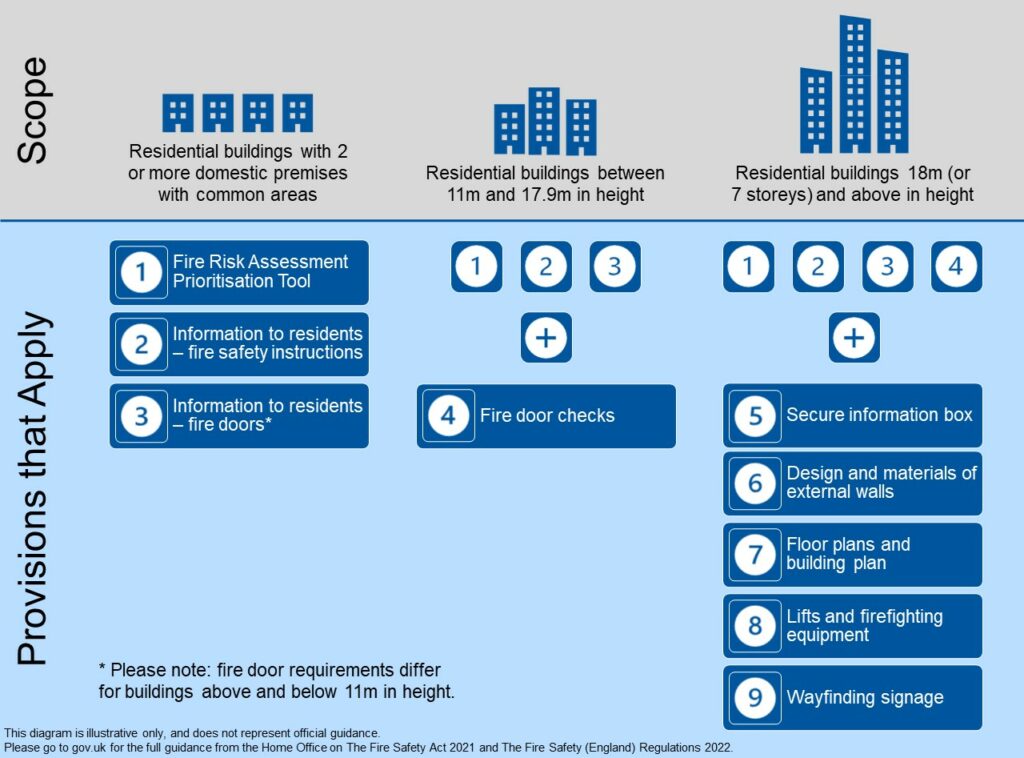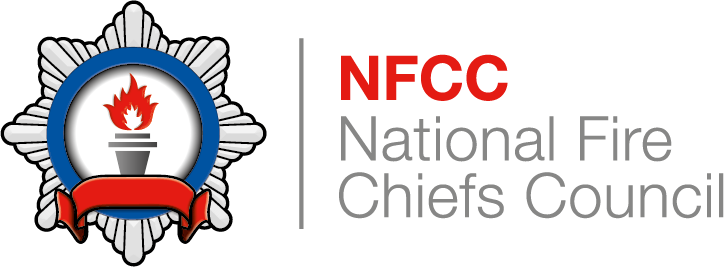Fire Safety (England) Regulations 2022 FAQs
Frequently Asked Questions (FAQs)
What do the new regulations do?
The regulations extend the duties imposed on responsible persons by the Regulatory Reform (Fire Safety) Order 2005 (Fire Safety Order) and represent the practical implementation of the majority of the recommendations made to government in the Grenfell Tower Inquiry Phase 1 report.
These regulations make it a requirement in law for responsible persons of high-rise blocks of flats to provide information to fire and rescue services to assist them in planning for, and responding to, an incident in their building.
The regulations will also require responsible persons in multi-occupied residential buildings, which are high-rise buildings, as well as those above 11 metres in height, to provide additional safety measures.
In all multi-occupied residential buildings, the regulations require responsible persons to provide residents with fire safety instructions and information on the importance of fire doors. The regulations apply to existing buildings, and requirements for new buildings may be different.
When do the regulations take effect from?
The regulations came into force on 23 January 2023.
Do these regulations only apply to England?
Yes, these regulations are only applicable to England.
What do the regulations require responsible persons to do?
The Regulations require Responsible Persons (RPs) of multi-occupied residential buildings to take specific actions, depending on the height of the building:
- some provisions apply regardless of height
- more are needed once a building reaches 11 metres, and
- Further requirements are introduced when a building reaches 18 metres (or 7 storeys) or more.
The Regulations set out requirements for RPs of all multi-occupied residential buildings, with two or more sets of domestic premises:
- Fire Safety Information to Residents: the RP must provide fire safety information to their residents on how to report a fire and what a resident must do once a fire has occurred.
- Fire Door Information: the RP must provide residents with information relating to the importance of fire doors in fire safety.

The Regulations set out additional requirements for RPs of multi-occupied residential buildings of over 11 metres in height:
- Fire door checks: the RP should carry out annual checks of flat entrance doors. They must also undertake quarterly checks of all fire doors in the common parts.
The requirements are greatest for high-rise residential buildings (at least 18m or 7 storeys in height):
- Secure Information Boxes: the RP must install and maintain a secure information box in their building. This box must contain the name and contact details of the RP and hard copies of the building and floor plans.
- External Wall Systems: the RP must prepare a record of the design of the external walls of the building, including the materials used in their construction. The record must provide information on the level of fire risk associated with the externals and any mitigating steps that have been taken. The RP is required to electronically share a copy of the record with the local fire and rescue service
- Building Plans: the RP must prepare up-to-date floor plans, alongside a single page building plan which identifies key firefighting equipment. The RP is required to electronically share copies of the plans with the local fire and rescue service, as well as provide paper copies of the plans within the premises’ secure information box.
- Lifts and other Key Fire-Fighting Equipment: the RP must undertake routine monthly checks of lifts intended for use by firefighters, evacuation lifts, and other key pieces of firefighting equipment. Any faults identified with equipment that cannot be rectified within 24 hours should be reported to the local fire and rescue service via electronic means.
- Way finding Signage: the RP must install floor identification signs and flat indicator signs. The signage is intended to assist responding firefighters and should be visible in low light or smoky conditions.
How do I submit my information to the fire and rescue services, and what is the format for sharing information electronically?
It is a matter for each FRS to put in place arrangements for receiving electronic copies of external wall reports, floor and building plans, and fault reports. Whilst the information being shared should be consistent across FRSs, the format in which each FRS will prefer to receive that information may vary. This will be clearly communicated on their website.
What else do responsible persons need to do?
The commencement of the Fire Safety Act in May 2022 clarified that the building’s structure and external walls (including windows, balconies, cladding, insulation, and fixings) fall within the scope of the Fire Safety Order. Accordingly, the risk of fire relating to the external walls is a matter which should be considered as part of the premises fire risk assessment.
Given information related to this risk must also be included within the record of the external wall required by the new Regulations, fire risk assessments that do not currently consider the external wall should be updated as quickly as practicable.
To support the updating of fire risk assessment in line with the clarifications set out in the Fire Safety Act, the government has developed the Fire Risk Assessment Prioritisation Tool (the FRAPT).
What do fire and rescue services need to do now?
The Regulations came into force on 23 January 2023. The Home Office has published the guidance document Check your fire safety responsibilities under the Fire Safety (England) Regulations 2022.
FRSs will need to be aware that the Regulations will have implications for audit, inspection, and enforcement activity of residential buildings under the FSO (Fire Safety Order). Some FRSs may have already considered changes to their audit methodology to take account of these changes. If not, it is necessary for FRSs to evaluate the need for this now.
FRSs should be ready to provide advice to assist RPs in understanding and complying with their duties.
What is NFCC doing to support FRSs and RPs?
NFCC has worked closely with the Home Office and local fire and rescue services to develop standard templates to support the information sharing requirements of the regulations. The provision of templates will assist both RPs and FRS by helping to ensure the information is captured and shared in a consistent format.
NFCC has previously provided an Enforcement guide and toolkit to support FRSs in high-rise residential buildings. An update of this guide now that the Regulations have been brought forward is being finalised, and NFCC hope to provide this to FRSs shortly.
Where can I find out more information?
The Fire Safety (England) Regulations 2022 can be found on the UK Government website.
The Home Office has published the following guidance documents to assist RP’s in complying with the new legislation:
- Guidance: Check your fire safety responsibilities under the Fire Safety (England) Regulations
- Guidance: Fire Safety (England) Regulations 2022: Fire door guidance
Further guidance on Secure Information Boxes and building and floor plans, including examples of best practice, is available from the Fire Industry Association.
In addition to guidance, the Home Office also produced a series of fact sheets which provide more detailed information on the individual requirements of the regulations. The fact sheets are available on the UK Government website.
- Overview Fact Sheet
- Secure Information Box Fact Sheet
- Design and Materials of External Walls Fact Sheet
- Floor Plans and Building Plan Fact Sheet
- Lifts and Essential Fire-fighting Equipment Fact Sheet
- Way finding Signage Fact Sheet
- Information to Residents Fact Sheet
- Fire Doors Fact Sheet
If you have any questions, please contact us at ppruadminteam@nationalfirechiefs.org.uk.
